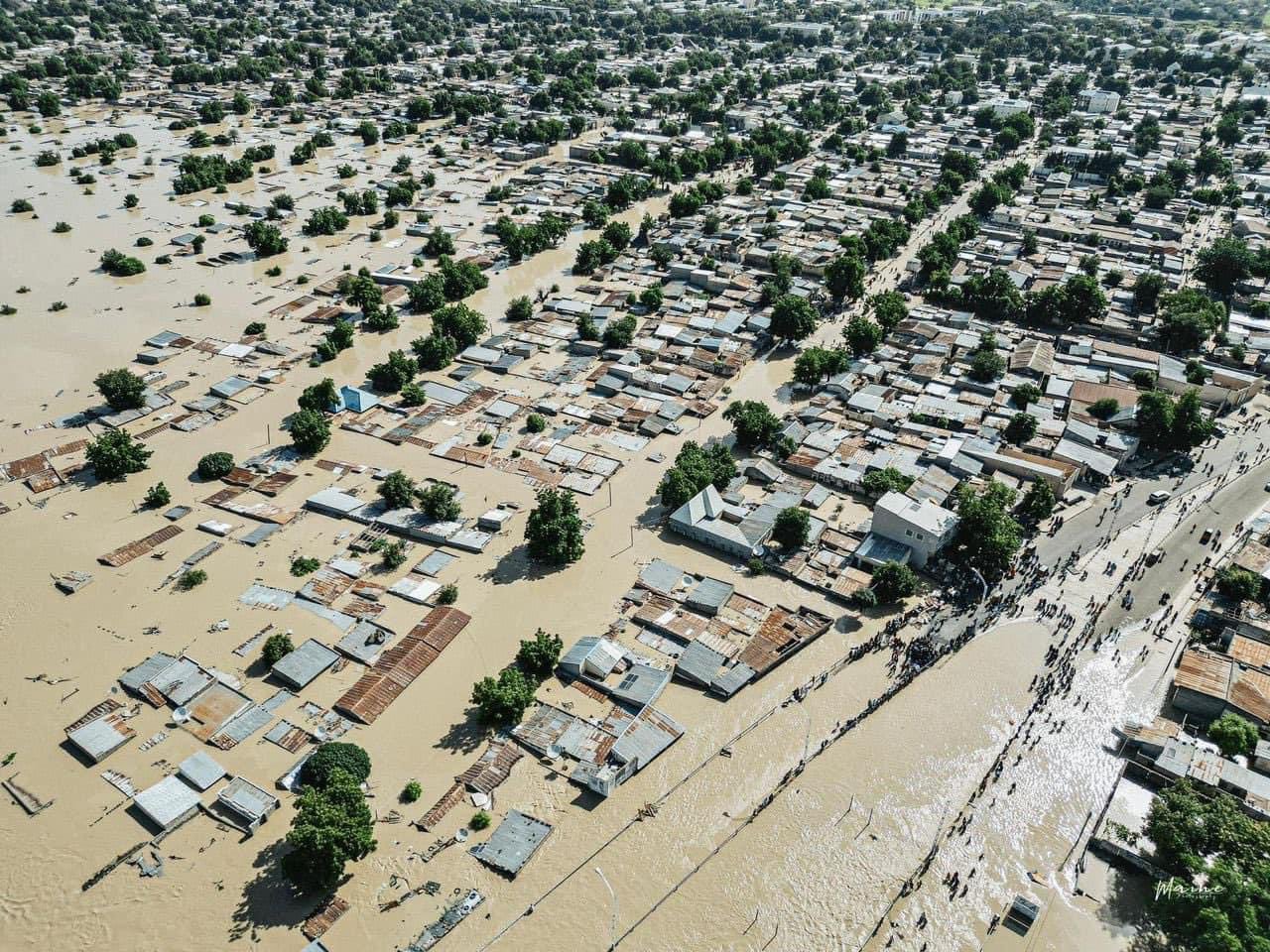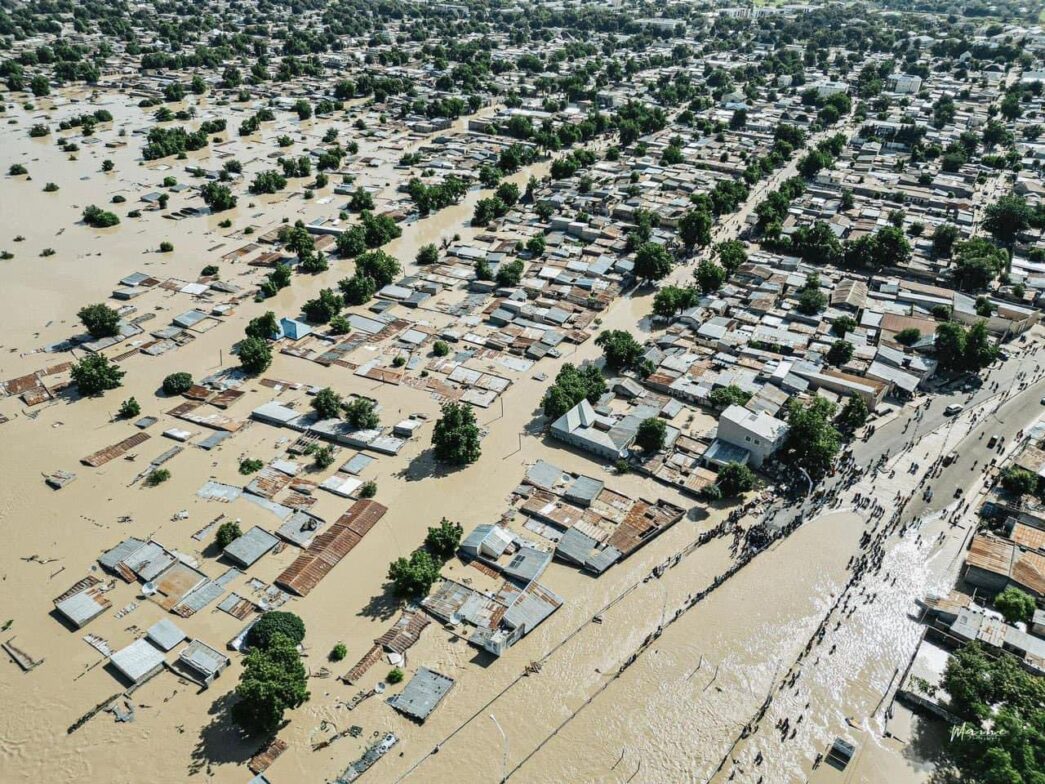An aerial view of some areas affected by the flood in Maiduguri
I have read many comments and reactions trailing the flood in Maiduguri, the Borno state capital. Many people are left in oblivion as to whether the disaster was caused by climate change or the usual failure of the government to maintain its infrastructure.
There is nothing unusual for observers, analysts, and victims to find who or what to blame in situations like this. It is only normal to analyse it, spot where the fault or problem came from, and proffer a solution.
The flood, caused by the collapse of Alau Dam, has led to many disasters including the displacement of many residents, alleged jailbreak, and even displacement of dangerous animals. The flood has sent humans and animals out of their comfort zones.
After reaching its full capacity of 112 million cubic meters for a whole week and possibly exceeding it, the Alau Dam collapsed on Tuesday morning, resulting in a devastating flood that has made thousands of residents homeless, seeking temporary refuge and livelihood.
Advertisement
In a statement that probably should have been made one week earlier, Prof. Usman Tar, the commissioner for information and internal security, on Tuesday called for immediate evacuation while alerting residents of the river bank areas of the disaster that has already befallen them.
“Due to the unusually high volume of water this year, we urge all the residents living along the river bank to take immediate action to protect themselves and their properties. The Alau Dam water has broken down another channel that is currently destroying farms and the water is heading toward the river bank.” These were his words.
The damages this flood has caused are enormous, children and adults are now faced with the dangers of attack from wild animals, properties have been destroyed, sources of livelihood lost, and they face the risk of suffering serious health conditions.
Advertisement
The Chairman of CSOs, Lake-Chad Basin, Ahmed Shehu, expressed fears over the dangers this unfortunate development poses to human lives. According to him “the situation is so dire. The water flooded the zoo at midnight. Though no one can tell the situation of the animals, definitely they will scamper for safety and in the process cause harm to the community.
“It is the same water route that displaced people are taking, the animals will take too. Aside from wide animals escaping from the zoo, the Christian cemetery around Amb Baba Ahmed Jidda house in Old GRA has been submerged. This poses serious public health threats. The government needs to activate emergency response.”
Vice President Kashim Shettima, who is also a former governor of Borno state, visited the flood scene where he assessed the impact of the flood and provided hope for the victims.
The Alau Dam, which receives water from the Yedzram and Gombole rivers, is located in the Alau community of Konduga local government area of Borno state, Northeast Nigeria. It was constructed between the years of 1984 and 1986. It collapsed in 1994, leaving hundreds of thousands of people displaced.
Advertisement
Many questions are running in the minds of victims and sympathizers alike. Who or what should be held responsible for this disaster? We can do a little thinking in our heads like – “flood is natural”, “Oh no, it’s caused by the failure of the government to take proactive measures to prevent it”. “Wait, but water causes flood, and water comes from the sky”. “No, this flood is caused by the collapse of the Alau Dam”. “But the Alau Dam was filled with water before it collapsed”.
I must say that these arguments are valid and reasonable regardless of where you stand.
What is climate change?
According to the United Nations, climate change refers to long-term shifts in temperatures and weather patterns. Such shifts can be natural, due to changes in the sun’s activity or large volcanic eruptions. However, the UN says that since the 1800s, human activities have been the main driver of climate change, primarily due to the burning of fossil fuels like coal, oil, and gas.
Advertisement
With the definition above, we may agree that climate change can lead to a high volume of rainfall, consequently leading to a high level of water in the dam. However, this volume of rainfall can be caused by climate change or human activities, or both.
With that said a responsible and proactive government will not wait for an avoidable disaster like the collapse of the Alau Dam to happen before taking measures to save lives and properties. The current flood in Maiduguri is avoidable, especially in a situation where it has happened before.
Advertisement
Dams are important as they generate hydroelectric power, which is a renewable and emissions-free source of energy and helps to control floods. But just like they do so much to keep the environment safe, cultivable, and healthy, they need to be maintained frequently.
Though dams are built to last for many decades, they develop cracks and leakages over some time. This is why the importance of frequent inspection and repairs by a team of professionals cannot be overemphasized.
Advertisement
The onus is now on the government to prevent a reoccurrence of this menace. All major and minor dams in Nigeria and its environs should be given priority. For dams that have minor issues, they should be fixed before they become major and more expensive to deal with. For the irreparable ones, they should be replaced. And it’s important to use high-quality materials and follow best engineering practices when constructing a new dam.
Israel Ojoko, a journalist and data analyst, can be reached via [email protected]
Advertisement
Views expressed by contributors are strictly personal and not of TheCable.
Add a comment









